Note: Oil pre-filter and oil pump are part of the oil pan (top) and cannot be disassembled separately.
Removing
Note: When removing only the oil pan (lower) pp. 2 and 3 are not required. Perform step 5 after completing step 4
1. Remove the engine protection from the bottom.
2. Remove the engine and transmission assembly from the vehicle and separate them. See section «Complete engine».
3. Install the engine on the stand. See section «Cylinder block».
4. Drain the engine oil. See chapter Lubrication system and engine cooling system.
5. Remove the oil pan (lower) in the following way:
- A. Loosen the bolts in the reverse order shown in the figure.
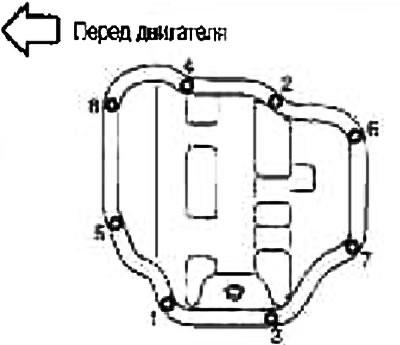
- b. Insert cutter (special tool: KV10111100) between the upper and lower oil pans.
Attention:
- Do not damage the contact surfaces.
- When shipped from the factory, a stronger sealant is applied than previously used sealants. Therefore, do not attempt to pry the drip tray off with a flat-blade screwdriver, etc.
6. Remove the front cover and timing chain. See section below «Valve train chain».
7. Remove the oil pump sprocket and crankshaft sprocket along with the oil pump drive chain. See section «Valve train chain».
8. Remove the oil pan (upper) in the following way:
- A. Loosen the oil pan mounting bolts (top) in the reverse order shown in the figure.

Use branded sealant or equivalent.
- b. Insert a curved flat-bladed screwdriver into the places marked with arrows in the figure and create a gap between the oil pan (top) and cylinder block.
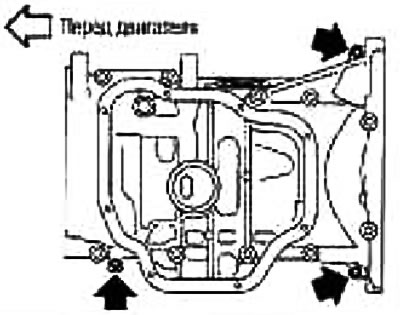
- With. Insert cutter (special tool: KV10111100) between the oil pan (top) and cylinder block. Move the cutter around the perimeter by tapping on its end with a hammer.
Attention:
- Do not damage the contact surfaces.
- When shipped from the factory, a stronger sealant is applied than previously used sealants. Therefore, you should not try to separate the drip tray with a screwdriver, etc. in areas other than those marked.
- Do not remove the oil pump and oil pre-filter from the oil pan (top).
9. Remove the rear oil seal from the crankshaft.
Installation
1. Install the oil pan (upper) in the following way:
- A. Use a scraper to remove any old sealant from the contact surfaces.
Also remove any old sealant from the contact surface of the cylinder block.
Remove old sealant from bolt holes and threads.
Caution: When removing the old sealant, do not scratch or damage the contact surfaces.
- b. Install the O-ring into the cylinder block.
- With. Apply sealant (WITH) continuous strip with a syringe (special tool: WS39930000) to the areas shown in the figure.

Use branded sealant or equivalent.
A. 2mm protrude
B. 2mm protrude towards rear oil seal installation
Attention: Installation must be carried out within 5 minutes after application.
- d. Tighten the bolts in the order indicated by the numbers in the figure.
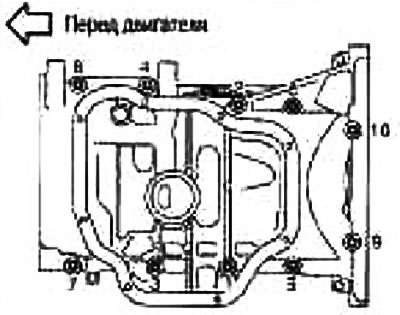
Caution: Be careful not to dislodge the oil pan gasket and O-ring when installing.
Bolt locations are shown below:
- M8 x 180 mm: 9.10
- M8 x 25 mm: 3.4 7.8
- M8 x 90 mm: 1,2,5, 6
2. Press in the rear oil seal as follows:
Attention: The installation of the rear oil seal must be carried out within 5 minutes after the installation of the oil pan (top). Do not touch the lip of the seal.
- A. Using a spatula, remove the sealant that has come out at the rear oil seal installation area on the oil pan (upper) and cylinder block.
- b. Apply a small amount of sealant around the outside of the new rear oil seal.
Use branded sealant or equivalent.
- With. Press in the rear oil seal using a drift with an outer diameter of 113 mm and an inner diameter of 90 mm (suitable special tool) (A)

Press in according to the dimensions shown in the figure on the next page.
Attention:
- Do not touch the grease applied to the lip of the seal.
- Do not damage the surface at the installation area of the rear oil seal on the oil pan (upper) and cylinder block or crankshaft.
- Press in at a right angle to avoid burr formation and distortion of the stuffing box.
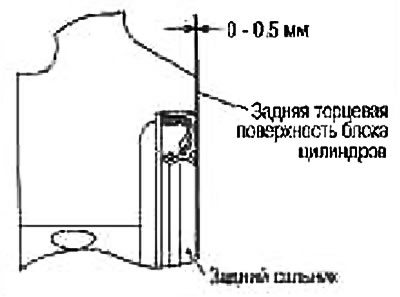
- d. After pressing the rear oil seal, completely remove the sealant that has come out from the side of the rear end.
3. Install the crankshaft sprocket, oil pump sprocket, oil pump drive chain and chain tensioner. See section «Valve train chain».
4. Install the timing chain and related components. See section «Valve train chain».
5. Install the front cover and related components. See section «Valve train chain».
6. Install the oil pan (lower) in the following way:
- A. Use a scraper to remove any old sealant from the contact surfaces.
Also remove any old sealant from the contact surface of the oil pan (top)
Remove any old sealant from the bolt holes and threads.
Caution: When removing the old sealant, do not scratch or damage the contact surfaces.
- b. Apply sealant (A) continuous strip with a syringe (special tool: WS39930000) to the areas shown in the figure.
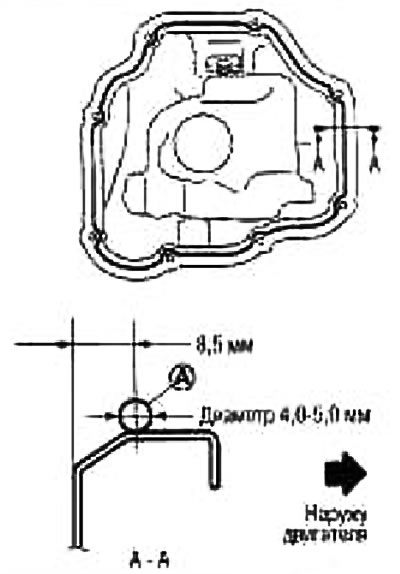
Use branded sealant or equivalent
Attention: Installation must be carried out within 5 minutes after application.
- With. Tighten the bolts in order, numbered in the figure.
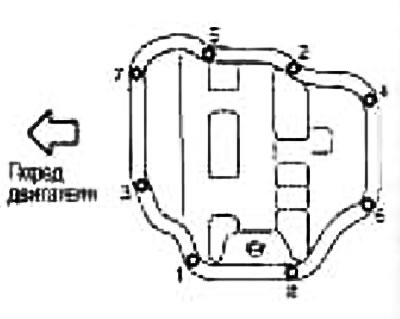
7. Screw the plug into the oil pan drain hole. The installation direction of the washer is higher in the illustration of the components. After this operation, installation is carried out in the reverse order of removal.
Check after installation
1. Check the oil level and top up. See chapter Lubrication system and engine cooling system.
2. Start the engine and check for engine oil leaks.
3. Stop the engine and wait a few minutes.
4. Check the oil level again. See chapter Lubrication system and engine cooling system.